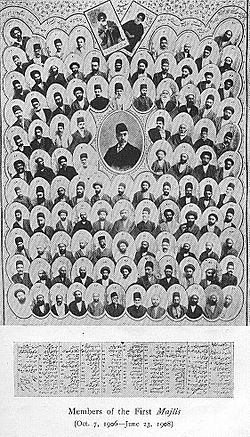
Back Constitució iraniana de 1906 Catalan Verfassung des Iran von 1906 German قانون اساسی مشروطه Persian Costituzione persiana del 1906 Italian Конституція Ірану 1906 року Ukrainian 1906年波斯憲法 Chinese
 Members of the First Majlis (October 7, 1906 — June 23, 1908). The central photograph is that of Morteza Gholi Khan Hedayat, aka Sani-ol Douleh, the first Chairman of the First Majlis. He had been for seven months the Finance Minister when he was assassinated on 6 February 1911 by two Georgian nationals in Tehran.[1] | |
| Location | Qajar Iran |
|---|---|
| Media type | Constitution |

The Persian Constitution of 1906[2][3][4] (Persian: قانون اساسی مشروطه, romanized: Qānun-e Asāsi-ye Mashrute), was the first constitution of the Sublime State of Persia (Qajar Iran), resulting from the Persian Constitutional Revolution and it was written by Hassan Pirnia, Hossein Pirnia, and Esmail Momtaz, among others.[5] The Constitution was also in effect during Pahlavi Iran. It divides into five chapters with many articles that developed over several years. The Quran was the foundation of this constitution while the Belgian constitution served as a partial model for the document, which guaranteed each citizen equality before the law, and a safeguarding of personal honour, property and speech.[6][7]
- ^ W. Morgan Shuster, The Strangling of Persia, 3rd printing (T. Fisher Unwin, London, 1913), pp. 48, 119, 179. According to Shuster (p. 48), "Five days later [measured from February 1st] the Persian Minister of Finance, Saniu'd-Dawleh was shot and killed in the streets of Teheran by two Georgians, who also succeeded in wounding four of the Persian police before they were captured. The Russian consular authorities promptly refused to allow these men to be tried by the Persian Government, and took them out of the country under Russian protection, claiming that they would be suitably punished."
See also: Mohammad-Reza Nazari, The retreat by the Parliament in overseeing the financial matters is a retreat of democracy, in Persian, Mardom-Salari, No. 1734, 20 Bahman 1386 AH (9 February 2008), "عقب نشيني مجلس در نظارت مالي عقب نشيني دموکراسي است". Archived from the original on 2009-04-27. Retrieved 2007-10-13.. - ^ Tilmann J. Röder, The Separation of Powers: Historical and Comparative Perspectives, in: Rainer Grote and Tilmann J. Röder, Constitutionalism in Islamic Countries (Oxford University Press 2012), p. 321-3372. The article includes scientific English translation of the following documents: The Fundamental Law (Qanun-e Asasi-e Mashruteh) of the Iranian Empire of December 30, 1906 (p. 359-365); The Amendment of the Fundamental Law of the Iranian Empire of October 7, 1907 (p. 365-372).
- ^ * The Mashruteh Constitution of Iran (farsi). Berlin 2014. ISBN 9783844292923. (Details)
- ^ Recognizing the centennial anniversary Archived 2016-01-17 at the Wayback Machine 109th CONGRESS, 2d Session, H. RES. 942, 25 July 2006
- ^ For a modern English translation of the constitution and related laws see, Tilmann J. Röder, The Separation of Powers: Historical and Comparative Perspectives, in: Grote/Röder, Constitutionalism in Islamic Countries (Oxford University Press 2011).
- ^ Destrée, Annette. "BELGIAN-IRANIAN RELATIONS". Encyclopædia Iranica. Retrieved 2015-08-21.
- ^ Anderson, Betty S. (2016). A history of the modern Middle East: rulers, rebels, and rogues. Stanford, California: Stanford University Press. ISBN 978-0-8047-8324-8.
© MMXXIII Rich X Search. We shall prevail. All rights reserved. Rich X Search